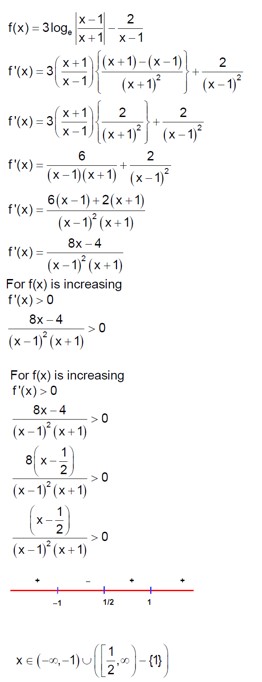Continuity and Differentiability
Get insights from 335 questions on Continuity and Differentiability, answered by students, alumni, and experts. You may also ask and answer any question you like about Continuity and Differentiability
Follow Ask QuestionQuestions
Discussions
Active Users
Followers
New answer posted
2 months agoContributor-Level 10
f (x) is an even function
So, f (x) has at least four roots in (-2, 2)
So, g (x) has at least two roots in (-2, 2)
now number of roots of f (x)
It is same as number of roots of will have atleast 4 roots in (-2, 2)
New answer posted
2 months agoContributor-Level 10
f (x) = f (6 – x) Þ f' (x) = -f' (6 – x) …. (1)
put x = 0, 2, 5
f' (0) = f' (6) = f' (2) = f' (4) = f' (5) = f' (1) = 0
and from equation (1) we get f' (3) = -f' (3)
So f' (x) = 0 has minimum 7 roots in
h (x) = f' (x) . f' (x)
h' (x) = (f' (x)2 + f' (x) f' (x)
h (x) = 0 has 13 roots in x
h' (x) = 0 has 12 roots in x
New answer posted
2 months agoContributor-Level 10
1 + x? - x? = a? (1+x)? + a? (1+x) + a? (1+x)² . + a? (1+x)?
Differentiate
4x³ - 5x? = a? + 2a? (1+x) + 3a? (1+x)².
12x² - 20x³ = 2a? + 6a? (1+x).
Put x = -1
12 + 20 = 2a? ⇒ a? = 16
New answer posted
2 months agoContributor-Level 10
The functional equation f (x+y) = f (x)f (y) implies f (x) = a? for some constant a.
Then f' (x) = a? ln (a).
Given f' (0) = 3, we have a? ln (a) = 3 ⇒ ln (a) = 3 ⇒ a = e³.
So, f (x) = e³?
We need to evaluate the limit: lim (x→0) (f (x)-1)/x = lim (x→0) (e³? -1)/x.
Using the standard limit lim (u→0) (e? -1)/u = 1, we can write:
lim (x→0) 3 * (e³? -1)/ (3x) = 3 * 1 = 3.
New answer posted
2 months agoContributor-Level 10
To find the values of a and b, we evaluate the left-hand limit (LHL) and right-hand limit (RHL) at x=0 and equate them.
LHL: lim (x→0) sin (a+3)/2 * x / x = (a+3)/2. The full limit evaluates to (a+3)/2. So, (a+3)/2 = b.
This gives the relation a - 2b + 3 = 0 — (I)
RHL: lim (x→0) [√ (x+bx³) - √x] / (bx²).
Rationalize the numerator:
lim (x→0) [ (x+bx³) - x] / [bx² (√ (x+bx³) + √x)]
= lim (x→0) bx³ / [bx² (√x (√ (1+bx²) + √x)]
= lim (x→0) x / [√x (√ (1+bx²) + 1)] = lim (x→0) √x / (√ (1+bx²) + 1) = 0/2 = 0.
So, b = 0.
Substituting b=0 into equation (I): a - 2 (0) + 3 = 0 ⇒ a = -3.
New answer posted
2 months agoContributor-Level 10
f (x) = (cos (sin x) - cos x) / x? We need lim (x→0) f (x) = 1/k.
Using cos C - cos D = -2 sin (C+D)/2) sin (C-D)/2).
f (x) = -2 sin (sin x + x)/2) sin (sin x - x)/2) / x?
For small x, sin x ≈ x.
lim (x→0) f (x) = lim -2 * ( (sin x + x)/2 ) * ( (sin x - x)/2 ) / x?
Using series expansion: sin x = x - x³/3! + x? /5! - .
sin x + x = 2x - x³/6 + .
sin x - x = -x³/6 + x? /120 - .
f (x) ≈ -2 * ( (2x)/2 ) * ( (-x³/6)/2 ) / x?
≈ -2 * (x) * (-x³/12) / x?
≈ (2x? /12) / x? = 2/12 = 1/6.
So, 1/k = 1/6 ⇒ k = 6.
New answer posted
2 months agoContributor-Level 10
We need to evaluate lim (x→0? ) (cos? ¹ (x - [x]²) ⋅ sin? ¹ (x - [x]²) / (x - x²).
As x → 0? , the greatest integer [x] = 0.
So the expression becomes:
lim (x→0? ) (cos? ¹ (x) ⋅ sin? ¹ (x) / (x (1 - x²)
= lim (x→0? ) cos? ¹ (x) * lim (x→0? ) (sin? ¹ (x) / x) * lim (x→0? ) (1 / (1 - x²)
We know lim (x→0) (sin? ¹ (x) / x) = 1.
lim (x→0? ) cos? ¹ (x) = cos? ¹ (0) = π/2.
lim (x→0? ) (1 / (1 - x²) = 1 / (1 - 0) = 1.
So the limit is (π/2) * 1 * 1 = π/2.
New answer posted
2 months agoContributor-Level 10
f (x) is differentiable then will also continuous then f (π) = -1, f (π? ) = -k?
k? = 1
Now f' (x) = { 2k? (x-π) if x≤π
{ -k? sinx if x>π
then f' (π? ) = f' (π? ) = 0
f' (x) = { 2k? if x≤π
{ -k? cosx if x>π
then 2k? =k?
k? = 1/2
Taking an Exam? Selecting a College?
Get authentic answers from experts, students and alumni that you won't find anywhere else
Sign Up on ShikshaOn Shiksha, get access to
- 65k Colleges
- 1.2k Exams
- 679k Reviews
- 1800k Answers

